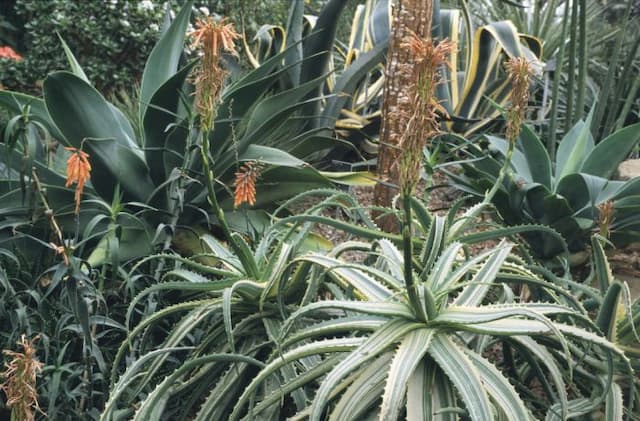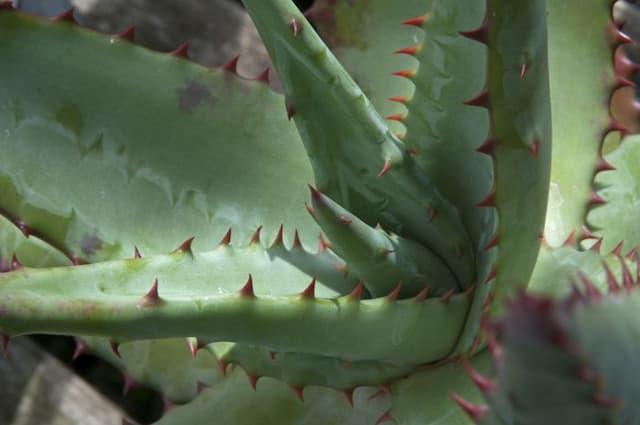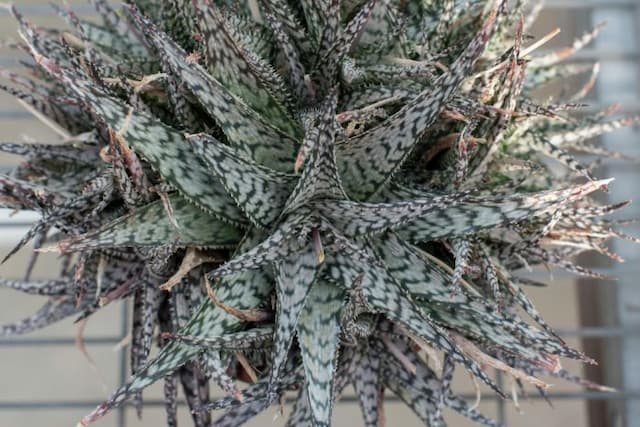Red Hot Poker Kniphofia 'Cobra'

ABOUT
The Cobra, also known as Red Hot Poker, is a striking perennial that bears unique and eye-catching flowers. The blossom spikes exhibit a gradient of color, often appearing in warm shades like yellow, orange, and fiery red, reminiscent of a torch or flaming poker. These flower spikes are densely packed with tubular florets and rise elegantly above the foliage. The leaves of the Cobra plant form a clump at the base and are typically long, slender, and grass-like in appearance with a rich green color. The flowers extend upwards on sturdy, upright stems that stand above the leafy tufts. The textural contrast between the spiky blooms and the soft, arching foliage creates an interesting visual dynamic in the garden. Throughout the blooming season, the Cobra can be a magnet for hummingbirds, butterflies, and other pollinators, adding both color and vibrant wildlife activity to any planting space. The distinctiveness of its flower spikes makes it a favorite among gardeners looking for a plant with a bold visual impact.
About this plant
 Names
NamesFamily
Asphodelaceae
Synonyms
Red Hot Poker, Torch Lily, Tritoma
Common names
Kniphofia 'Cobra'.
 Toxicity
ToxicityTo humans
Red hot poker, also known by its scientific name Kniphofia 'Cobra', is not typically known for being toxic to humans. However, as with many plants, it is generally not advisable to ingest any part of it. There is no well-documented evidence of serious poisoning from consuming red hot poker. If any symptoms were to occur from accidental ingestion, they might include mild gastrointestinal discomfort such as nausea or vomiting. Always exercise caution and keep plants away from young children who might inadvertently eat plant material.
To pets
Red hot poker, or Kniphofia 'Cobra', is not widely recognized as being toxic to pets. Nonetheless, ingestion of plant material by pets, especially dogs and cats, is often not recommended. There is a lack of substantial evidence linking red hot poker to significant poisoning cases in pets. If a pet were to consume parts of this plant, they might experience mild gastrointestinal upset, including symptoms such as vomiting or diarrhea. It's always prudent to prevent pets from eating ornamental plants as a precautionary measure.
 Characteristics
CharacteristicsLife cycle
Perennials
Foliage type
Evergreen
Color of leaves
Green
Flower color
Mixed
Height
3-4 feet (0.91-1.22 meters)
Spread
2-3 feet (0.61-0.91 meters)
Plant type
Herb
Hardiness zones
6
Native area
Africa
Benefits
 General Benefits
General Benefits- Attracts Pollinators: Kniphofia 'Cobra', commonly known as Red Hot Poker, attracts bees, butterflies, and hummingbirds, helping to support local ecosystems.
- Drought Tolerant: Once established, Red Hot Pokers are quite drought-resistant, making them suitable for xeriscaping and water-conscious gardening.
- Low Maintenance: This plant requires minimal upkeep beyond occasional watering and trimming, which is ideal for gardeners seeking low-effort plants.
- Architectural Interest: With its striking vertical form and bold flower spikes, Red Hot Poker adds architectural interest to any garden design.
- Long Blooming: The plant has a long flowering season, often from late spring through summer, providing consistent color and vibrancy in the garden.
- Deer and Rabbit Resistant: Red Hot Poker is generally resistant to grazing by deer and rabbits, making it a good choice for areas where wildlife browsing is a problem.
 Medical Properties
Medical PropertiesThis plant is not used for medical purposes.
 Air-purifying Qualities
Air-purifying QualitiesThis plant is not specifically known for air purifying qualities.
 Other Uses
Other Uses- Red hot poker can be used as a natural dye source, with the plant's flowers providing a range of warm hues for fabrics.
- It can serve as a focal point in floral arrangements, adding vertical interest and a splash of color in large bouquets or centerpieces.
- The dried seed pods of red hot poker can be used in crafting, for example by incorporating them into homemade wreaths or decorative displays.
- Red hot poker's strong vertical lines can be used to create rhythm and movement in garden design, drawing the eye along paths or borders.
- When planted en masse, red hot poker can be used as a living fence, marking boundaries or creating private spaces within gardens.
- The plant can act as a natural pest deterrent, as its robust foliage can be less appealing to deer and other garden nibblers.
- Red hot poker can be used in xeriscaping, due to its drought resistance, providing color and interest in low-water-use gardens.
- In garden ponds or water features, red hot poker can provide vertical accents amongst lower-lying water plants, such as water lilies.
- The flowers can be used to add color and a touch of exotic appeal to edible landscapes, though they are not known to be edible themselves.
- When planted in school gardens or educational spaces, red hot poker can be used to demonstrate plant adaptation and pollination to students.
Interesting Facts
 Feng Shui
Feng ShuiThe Red Hot Poker is not used in Feng Shui practice.
 Zodiac Sign Compitability
Zodiac Sign CompitabilityThe Red Hot Poker is not used in astrology practice.
 Plant Symbolism
Plant Symbolism- Stand Out in a Crowd: The Kniphofia 'Cobra', commonly known as the Red Hot Poker, has bold and bright flower spikes that demand attention. This symbolizes the ability to stand out and be noticed among others.
- Attraction and Vibrancy: With its fiery colors, Red Hot Poker is often associated with attraction and vibrancy, making it a symbol for those who are passionate and full of life.
- Strength and Endurance: The sturdy and upright stems of the Red Hot Poker typically symbolize strength and the ability to endure challenging circumstances.
- Warmth and Hospitality: The warm colors of the flowers can also be a symbol of the warmth and hospitality one exhibits towards others, inviting and welcoming in nature.
 Water
WaterRed Hot Poker plants prefer consistent moisture, especially during the growing season, and shouldn't be allowed to dry out entirely. Water the Kniphofia 'Cobra' deeply once a week, providing about 1 inch of water or roughly 0.6 gallons per square foot of soil, ensuring water penetrates the root zone. Adjust the frequency during periods of extreme heat or drought by increasing watering to twice a week. In cooler temperatures or when rainfall is sufficient, reduce watering accordingly. Always check the soil moisture before watering to avoid overwatering, which can lead to root rot. During the winter or when the plant is dormant, water sparingly, only enough to prevent the soil from completely drying out.
 Light
LightRed Hot Poker plants thrive in full sunlight, requiring a minimum of six hours of direct sun exposure daily to flourish. The best spot for Kniphofia 'Cobra' would be an open area without shade from trees or buildings to ensure it receives abundant sunlight. While it can tolerate some light shade, too much shade can lead to weak growth and fewer blooms, so a spot with ample sunlight is preferable for robust growth and vibrant flower spikes.
 Temperature
TemperatureThe Red Hot Poker plant is hardy and can withstand temperatures as low as 10°F, but it performs best in temperatures ranging from 60°F to 75°F. Extreme cold below 10°F can damage the plant, and in areas with harsh winters, providing mulch or shelter may be necessary to protect it. Kniphofia 'Cobra' enjoys warm conditions and can tolerate high temperatures, making it suitable for many temperate climates, but it should be monitored for heat stress during unusually hot spells.
 Pruning
PruningPruning Red Hot Poker plants increases air circulation and encourages more vigorous blooms. Trim off spent flower stalks at the base after blooming to encourage a tidy appearance and potential reblooming. In late fall or early spring, cut back the foliage to about 3 inches above the ground to remove any dead or damaged leaves and promote fresh growth. Pruning is typically done once a year, at the end of the season, or in early spring before the new growth starts.
 Cleaning
CleaningAs needed
 Soil
SoilKniphofia, commonly known as Red Hot Poker, thrives best in well-draining soil with a slightly acidic to neutral pH of 6.0 to 7.0. A good soil mix for Red Hot Poker would be equal parts garden soil, coarse sand, and compost to ensure proper drainage and fertility.
 Repotting
RepottingRed Hot Poker plants generally do not need to be repotted often as they prefer to be undisturbed. Young plants may be repotted once they outgrow their pots, but mature plants can be left for several years unless the soil is exhausted or the plant has outgrown its space.
 Humidity & Misting
Humidity & MistingRed Hot Poker plants are quite tolerant of varying humidity levels and do not have specific humidity requirements. They are adaptable to the typical outdoor conditions where they are usually grown.
 Suitable locations
Suitable locationsIndoor
Ensure bright light, minimal water, no indoor humidity needs.
Outdoor
Plant in full sun, well-drained soil, space clumps.
Hardiness zone
5-9 USDA
 Life cycle
Life cycleThe life of the Red Hot Poker 'Cobra' begins with seed germination, which requires well-drained soil and warmth. Once germinated, seedlings grow into sturdy plants with evergreen, strap-like foliage. The Red Hot Poker undergoes vegetative growth, forming clumps that can be divided in spring or autumn topropagate new plants. Annually, usually from late spring to early summer, the plant produces tall flowering spikes with tubular flowers that transition from yellow to orange-red, attracting pollinators such as hummingbirds and bees. After blooming, seed pods develop on the flower spikes, which, when ripe, can be harvested for propagation or allowed to self-seed in favorable conditions. The plant then enters a period of dormancy during colder months, although the foliage remains, with reduced activity until the next growing season.
 Propogation
PropogationPropogation time
Early spring
The most popular method of propagation for the Red Hot Poker, or Kniphofia 'Cobra', is by division. This process is best done in the spring, just before the plant begins its active growth for the season. To propagate by division, carefully dig up the entire plant and gently separate it into smaller clumps, ensuring that each clump has a portion of the root system intact. These clumps can then be immediately replanted in a suitable location with well-draining soil. It's important to water the new divisions thoroughly to help establish them in their new environment. This type of vegetative propagation ensures that the new plants will bear the same characteristics as the parent plant.









